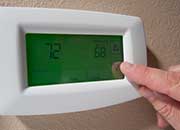
THURSDAY, Jan. 8, 2015 (HealthDay News) — Cold temperatures may raise levels of calorie-burning “brown fat” in your body, a new study conducted with mice suggests.
Unlike white fat, brown fat burns calories instead of storing them, and some studies have shown that brown fat has beneficial effects on glucose (blood sugar) tolerance, fat metabolism and body weight.
“Overall, the percentage of brown fat in adults is small compared to white fat,” study lead author Hei Sook Sul, professor of nutritional science and toxicology at the University of California, Berkeley, said in a university news release. “We also know that obese people have lower levels of brown fat.”
Now, her team’s experiments with mice revealed that exposure to cold increased levels of a protein called transcription factor Zfp516. The protein plays a critical role in the formation of brown fat, the researchers said.
Higher levels of the protein also seemed to help white fat become more similar to brown fat in its ability to burn calories, the researchers said.
As well, mice with elevated levels of the protein gained 30 percent less weight when fed a high-fat diet compared to normal mice. Experts note that findings from animal studies often fail to translate to humans, so more studies will be needed.
However, “knowing which proteins regulate brown fat is significant because brown fat is not only important for [generating heat], but there is evidence that brown fat may also affect metabolism and insulin resistance,” Sul explained.
“If you can somehow increase levels of this protein through drugs, you could have more brown fat, and could possibly lose more weight even if eating the same amount of food,” she added.
Because many Americans spend most of their time indoors with controlled temperatures, their need for brown fat has decreased over time, the researchers said.
One the other hand, other research has shown that “outdoor workers in northern Finland who are exposed to cold temperatures have a significant amount of brown fat when compared to same-aged indoor workers,” Sul said.
Study co-lead author Jon Dempersmier, a Ph.D. student in nutritional science and toxicology at Berkeley, explained, “Brown fat is active, using up calories to keep the body warm.”
“It’ll burn fat, it’ll burn glucose. So the idea is that if we can harness this, we can try to use this in therapy for weight loss and for diabetes,” he said in the news release.
The study was published Jan. 8 in Molecular Cell.
More information
The U.S. National Institutes of Health has more about brown fat.
Copyright © 2025 HealthDay. All rights reserved.

